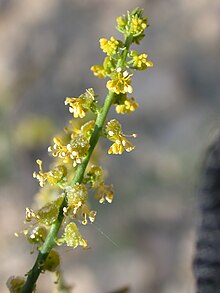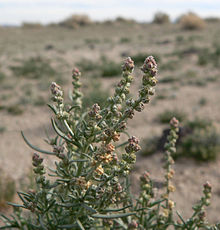Reseda plants
| Reseda plants | ||||||||||||
|---|---|---|---|---|---|---|---|---|---|---|---|---|

Yellow woof ( Reseda lutea ) |
||||||||||||
| Systematics | ||||||||||||
|
||||||||||||
| Scientific name | ||||||||||||
| Resedaceae | ||||||||||||
| Bercht. & J. Presl |
The Reseda plants (Resedaceae) are a family of plants in the order of the cruciferous (Brassicales).
description

Vegetative characteristics
They are herbaceous plants of one, two or more years . The alternate and spirally arranged leaves are stalked or sessile. The leaf blades are simple. Stipules are present.
Generative characteristics
Many flowers are grouped together in spiked or racemose inflorescences .
The mostly hermaphrodite flowers are zygomorphic with mostly a double flower envelope . There are usually six, rarely four or eight, sepals per flower . At petals rarely is there per flower usually six, no (at Ochradenus ), two (in Oligomeris ), four or eight petals (petals). There are three to about forty stamens and two to six carpels per flower . There is often a short gynophore between the stamen and carpel whorls . The ovary is on top.
Mostly, single-fan capsule fruits are formed, which often open at the top before the seeds are ripe.
distribution

The Reseda plants occur in temperate to subtropical climates . The main distribution area is the Mediterranean . Areas are also in Central Europe , Asia Minor , East Africa and South Africa . Some species are also found in southwestern North America and southern India .
Systematics
The Resedaceae family was established by Bedřich Všemír von Berchtold and Jan Svatopluk Presl .
In the Reseda family (Resedaceae) there are six genera with around 75 species:
- Caylusea A.St.-Hil. : With about three types. They occur in the Cape Verde Islands and from northern and eastern Africa to India.
- Ochradenus Del. : With about six species that occur in Libya, Pakistan and from the Middle East to Socotra.
-
Oligomeris Cambess. : With about two species in southwest Africa, plus:
- Oligomeris linifolia (Vahl) Macbride: It occurs in Asia, North Africa, the Canary Islands and southwest North America to Mexico. However, it did not come to North America in historical times, but also indigenous there.
- Randonia Cosson : With 1–3 species that occur in Africa and Arabia.
- Reseda ( Reseda L. ): With about 55 species that occur from the Mediterranean region and Europe to Central Asia.
- Sesamoides Ortega : With about 1–5 species that occur in the western Mediterranean area.
literature
- Otto Warburg : The flora. Volume 2: Family 4: Resedaceae or Reseda plants. Bibliographisches Institut Leipzig 1923, pp. 84–85.
- The family of Resedaceae in APWebsite . (engl.)
- The Resedaceae family at DELTA. (engl.)
- Resedaceae in the Germplasm Resources Information Network (GRIN), USDA , ARS , National Genetic Resources Program. National Germplasm Resources Laboratory, Beltsville, Maryland.
Individual evidence
- ↑ a b c d e f David John Mabberley: Mabberley's Plant-Book. A portable dictionary of plants, their classification and uses . 3rd ed. Cambridge University Press 2008. ISBN 978-0-521-82071-4
- ↑ Santiago Martin-Bravo, Pablo Vargas, Modesto Luceño: Is Oligomeris (Resedaceae) indigenous to North America? Molecular evidence for a natural colonization from the Old World. In: American Journal of Botany. Volume 96, No. 2, 2009, pp. 507-518, DOI: 10.3732 / ajb.0800216 .

